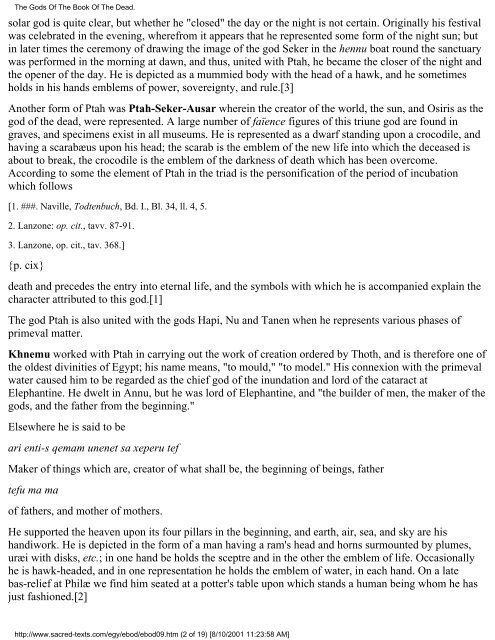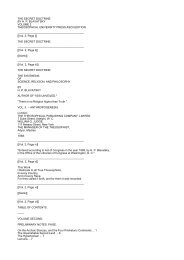You also want an ePaper? Increase the reach of your titles
YUMPU automatically turns print PDFs into web optimized ePapers that Google loves.
The Gods Of The <strong>Book</strong> Of The <strong>Dead</strong>.<br />
solar god is quite clear, but whe<strong>the</strong>r he "closed" <strong>the</strong> day or <strong>the</strong> night is not certain. Originally his festival<br />
was celebrated in <strong>the</strong> evening, wherefrom it appears that he represented some form <strong>of</strong> <strong>the</strong> night sun; but<br />
in later times <strong>the</strong> ceremony <strong>of</strong> drawing <strong>the</strong> image <strong>of</strong> <strong>the</strong> god Seker in <strong>the</strong> hennu boat round <strong>the</strong> sanctuary<br />
was performed in <strong>the</strong> morning at dawn, and thus, united with Ptah, he became <strong>the</strong> closer <strong>of</strong> <strong>the</strong> night and<br />
<strong>the</strong> opener <strong>of</strong> <strong>the</strong> day. He is depicted as a mummied body with <strong>the</strong> head <strong>of</strong> a hawk, and he sometimes<br />
holds in his hands emblems <strong>of</strong> power, sovereignty, and rule.[3]<br />
Ano<strong>the</strong>r form <strong>of</strong> Ptah was Ptah-Seker-Ausar wherein <strong>the</strong> creator <strong>of</strong> <strong>the</strong> world, <strong>the</strong> sun, and Osiris as <strong>the</strong><br />
god <strong>of</strong> <strong>the</strong> dead, were represented. A large number <strong>of</strong> faïence figures <strong>of</strong> this triune god are found in<br />
graves, and specimens exist in all museums. He is represented as a dwarf standing upon a crocodile, and<br />
having a scarabæus upon his head; <strong>the</strong> scarab is <strong>the</strong> emblem <strong>of</strong> <strong>the</strong> new life into which <strong>the</strong> deceased is<br />
about to break, <strong>the</strong> crocodile is <strong>the</strong> emblem <strong>of</strong> <strong>the</strong> darkness <strong>of</strong> death which has been overcome.<br />
According to some <strong>the</strong> element <strong>of</strong> Ptah in <strong>the</strong> triad is <strong>the</strong> personification <strong>of</strong> <strong>the</strong> period <strong>of</strong> incubation<br />
which follows<br />
[1. ###. Naville, Todtenbuch, Bd. I., Bl. 34, ll. 4, 5.<br />
2. Lanzone: op. cit., tavv. 87-91.<br />
3. Lanzone, op. cit., tav. 368.]<br />
{p. cix}<br />
death and precedes <strong>the</strong> entry into eternal life, and <strong>the</strong> symbols with which he is accompanied explain <strong>the</strong><br />
character attributed to this god.[1]<br />
The god Ptah is also united with <strong>the</strong> gods Hapi, Nu and Tanen when he represents various phases <strong>of</strong><br />
primeval matter.<br />
Khnemu worked with Ptah in carrying out <strong>the</strong> work <strong>of</strong> creation ordered by Thoth, and is <strong>the</strong>refore one <strong>of</strong><br />
<strong>the</strong> oldest divinities <strong>of</strong> Egypt; his name means, "to mould," "to model." His connexion with <strong>the</strong> primeval<br />
water caused him to be regarded as <strong>the</strong> chief god <strong>of</strong> <strong>the</strong> inundation and lord <strong>of</strong> <strong>the</strong> cataract at<br />
Elephantine. He dwelt in Annu, but he was lord <strong>of</strong> Elephantine, and "<strong>the</strong> builder <strong>of</strong> men, <strong>the</strong> maker <strong>of</strong> <strong>the</strong><br />
gods, and <strong>the</strong> fa<strong>the</strong>r from <strong>the</strong> beginning."<br />
Elsewhere he is said to be<br />
ari enti-s qemam unenet sa xeperu tef<br />
Maker <strong>of</strong> things which are, creator <strong>of</strong> what shall be, <strong>the</strong> beginning <strong>of</strong> beings, fa<strong>the</strong>r<br />
tefu ma ma<br />
<strong>of</strong> fa<strong>the</strong>rs, and mo<strong>the</strong>r <strong>of</strong> mo<strong>the</strong>rs.<br />
He supported <strong>the</strong> heaven upon its four pillars in <strong>the</strong> beginning, and earth, air, sea, and sky are his<br />
handiwork. He is depicted in <strong>the</strong> form <strong>of</strong> a man having a ram's head and horns surmounted by plumes,<br />
uræi with disks, etc.; in one hand be holds <strong>the</strong> sceptre and in <strong>the</strong> o<strong>the</strong>r <strong>the</strong> emblem <strong>of</strong> life. Occasionally<br />
he is hawk-headed, and in one representation he holds <strong>the</strong> emblem <strong>of</strong> water, in each hand. On a late<br />
bas-relief at Philæ we find him seated at a potter's table upon which stands a human being whom he has<br />
just fashioned.[2]<br />
http://www.sacred-texts.com/egy/ebod/ebod09.htm (2 <strong>of</strong> 19) [8/10/2001 11:23:58 AM]

















